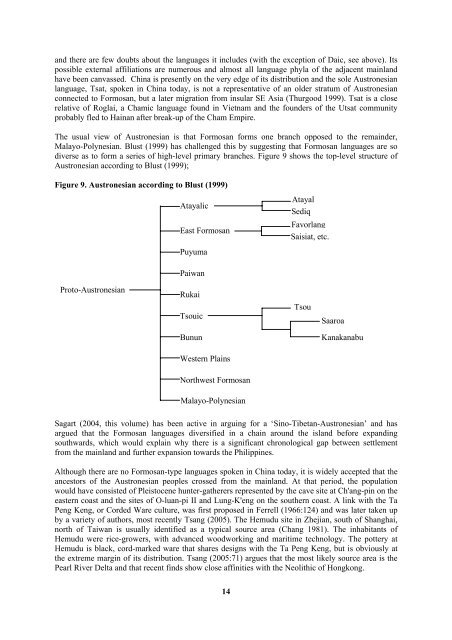Geneva paper 2004 submit.pdf - Roger Blench
Geneva paper 2004 submit.pdf - Roger Blench
Geneva paper 2004 submit.pdf - Roger Blench
You also want an ePaper? Increase the reach of your titles
YUMPU automatically turns print PDFs into web optimized ePapers that Google loves.
and there are few doubts about the languages it includes (with the exception of Daic, see above). Its<br />
possible external affiliations are numerous and almost all language phyla of the adjacent mainland<br />
have been canvassed. China is presently on the very edge of its distribution and the sole Austronesian<br />
language, Tsat, spoken in China today, is not a representative of an older stratum of Austronesian<br />
connected to Formosan, but a later migration from insular SE Asia (Thurgood 1999). Tsat is a close<br />
relative of Roglai, a Chamic language found in Vietnam and the founders of the Utsat community<br />
probably fled to Hainan after break-up of the Cham Empire.<br />
The usual view of Austronesian is that Formosan forms one branch opposed to the remainder,<br />
Malayo-Polynesian. Blust (1999) has challenged this by suggesting that Formosan languages are so<br />
diverse as to form a series of high-level primary branches. Figure 9 shows the top-level structure of<br />
Austronesian according to Blust (1999);<br />
Figure 9. Austronesian according to Blust (1999)<br />
Atayalic<br />
East Formosan<br />
Atayal<br />
Sediq<br />
Favorlang<br />
Saisiat, etc.<br />
Puyuma<br />
Proto-Austronesian<br />
Paiwan<br />
Rukai<br />
Tsouic<br />
Bunun<br />
Tsou<br />
Saaroa<br />
Kanakanabu<br />
Western Plains<br />
Northwest Formosan<br />
Malayo-Polynesian<br />
Sagart (<strong>2004</strong>, this volume) has been active in arguing for a ‘Sino-Tibetan-Austronesian’ and has<br />
argued that the Formosan languages diversified in a chain around the island before expanding<br />
southwards, which would explain why there is a significant chronological gap between settlement<br />
from the mainland and further expansion towards the Philippines.<br />
Although there are no Formosan-type languages spoken in China today, it is widely accepted that the<br />
ancestors of the Austronesian peoples crossed from the mainland. At that period, the population<br />
would have consisted of Pleistocene hunter-gatherers represented by the cave site at Ch'ang-pin on the<br />
eastern coast and the sites of O-luan-pi II and Lung-K'eng on the southern coast. A link with the Ta<br />
Peng Keng, or Corded Ware culture, was first proposed in Ferrell (1966:124) and was later taken up<br />
by a variety of authors, most recently Tsang (2005). The Hemudu site in Zhejian, south of Shanghai,<br />
north of Taiwan is usually identified as a typical source area (Chang 1981). The inhabitants of<br />
Hemudu were rice-growers, with advanced woodworking and maritime technology. The pottery at<br />
Hemudu is black, cord-marked ware that shares designs with the Ta Peng Keng, but is obviously at<br />
the extreme margin of its distribution. Tsang (2005:71) argues that the most likely source area is the<br />
Pearl River Delta and that recent finds show close affinities with the Neolithic of Hongkong.<br />
14
















